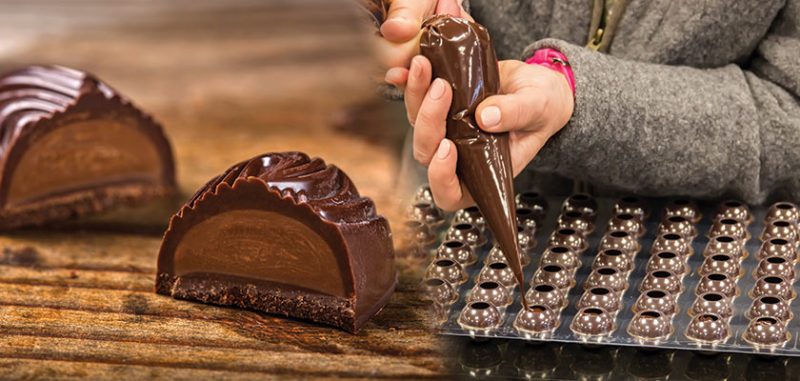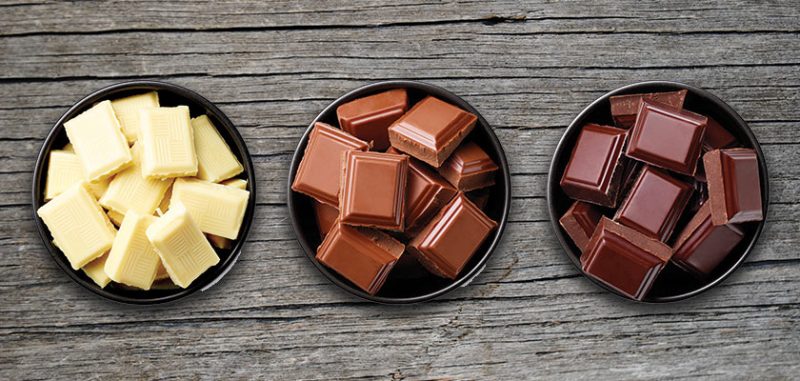Want to make molded chocolates, but need help choosing tools? Pro chocolatier Simon Knott explains the difference between 4 major types of chocolate making moulds, and how to choose the best one for your needs.
Making chocolates in moulds is a great way to exercise your creativity, and present your homemade treats in a way that your friends and customers will adore. But with all the different molds for chocolate making out there, including silicone, polycarbonate, 3D and magnetic, it can be difficult to know where to start.
As with most things, there is no one ‘best’ chocolate mold. Rather, the best one depends on your personal situation, including your budget, skill level, and what outcome you are looking to achieve. In this practical guide, Simon Knott discusses each type of chocolate making mold in detail, and shares his tips for how to choose the best type for your needs, plus recommendations for where to buy chocolate molds online.
What Chocolate Making Moulds Should I Get?
By Simon Knott, Professional Chocolatier
Chocolate melts at a low temperature and sets with good structural strength, making it a versatile ingredient for making many different products. Innovations in material science have innovated more reliable moulds, such as polycarbonate, Tritan (a transparent copolyester plastic), and silicone, each of which has specific advantages in chocolate moulding.
Various factors, such as the type of chocolates you want to make, the designs you prefer, and the level of detail you want to achieve, all affect the choice of the right chocolate mould. These are some considerations to help you decide:
What are the different types of chocolate making moulds?
Silicone chocolate making moulds
Silicone is a relatively cheap, non-toxic, flexible, and durable material, which, since its launch in the 1970s, has had a huge impact on chocolate and baking moulds. One of silicone’s biggest advantages is that it can be easily shaped to accommodate intricate and detailed designs, making it stand out from more traditional chocolate moulding materials.
Advantages
- Versatile – silicone remains useable from well below freezing up to oven temperatures of 230 °C (445 °F)
- Inexpensive – it’s much cheaper than polycarbonate.
- Durable – the service life of silicone moulds is about 2-3 years.
- Flexible – enables easier removal of set chocolates.
- Light – easy to work with
- Easy to clean and dishwasher-friendly.
Drawbacks, Challenges
- Chocolate finish – it creates a good finish but not as glossy as a polycarbonate mould.
- Prone to tearing – after extended use.
- Not rigid when filled with chocolate – the moulds are quite flexible and need to be supported underneath to avoid spillages.
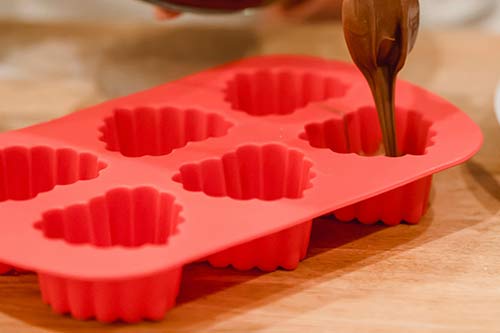
Polycarbonate chocolate making moulds
Polycarbonate moulds remain the first choice for most chocolatiers despite being more costly. The mould interior can be polished effectively, so they produce chocolates with a professional gloss. Before use, as with any mould, they must be cleaned thoroughly to remove all traces of chocolate and then polished using alcohol spray and a fine cloth.
Advantages
- Easy to polish, so the finish on the chocolate surface is excellent.
- On cooling, the heat of the chocolate is dispersed evenly for more uniform setting.
- Being transparent, you can monitor the chocolates as they cool in the mould and troubleshoot, if required.
Drawbacks, Challenges
- More expensive than other moulds
- Can scratch easily, which affects the finish on the chocolates.
- Chocolates can be difficult to extract if the mould isn’t polished adequately.
- Moulds can crack if dropped.
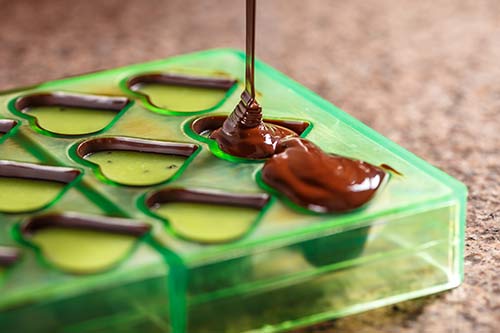
Spinning or 3D chocolate moulds
Both polycarbonate and silicone can be used to create spinning or 3-D moulds, which include many designs from animal figures to Easter eggs. You can also create your own designs at extra cost. Made as two halves, the mould is filled with tempered chocolate until the interior is evenly coated, and the excess is poured away, allowing the shell to set. Once fully hardened, the shells can be removed from the mould. The edge of each shell is then heated gently so the two halves can be cemented together around any inclusions.
Commercial operations use a spinning machine, which rotates moulds with liquid chocolate inside until it gradually sets in a uniform layer.
Advantages
- Creates the ability to make professional, complex, quality 3-D mould designs.
Drawbacks, Challenges
- Ad hoc designs can be expensive.
- Experience required to reliably produce quality products.
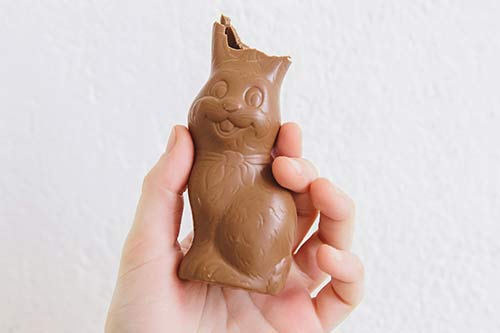
Magnetic chocolate molds
Magnetic or transfer moulds are used to transfer a coloured image from a transfer sheet to the top surface of the chocolate. The mould is made of three parts:
a. The main polycarbonate mould has openings on both sides and a series of magnets set within the plastic.
b. The transfer sheet is laid on the base of the mould, and the image to be transferred is facing up. The designs are printed with coloured cocoa butter for easy transfer to the chocolate.
c. The base plate, a stainless-steel sheet, is attached to the base of the mould and held in place by the magnets. The mould can then be filled and as the chocolate sets, the images on the sheet transfer onto the top of each chocolate.
Advantages
- Can create professional-looking chocolates with complex designs.
Drawbacks, Challenges
- Considerably more expensive than polycarbonate moulds. A standard polycarbonate mould is about $20 (£16.00), and a magnetic mould is about $50(£40.00).
- The moulds can only be used with a transfer sheet.
- Cleaning the moulds is more complicated.
- Can be a fiddly technique for beginners.
How to choose the best chocolate making moulds for your needs
When choosing the best moulds and chocolate for your production, assessing your specific needs is best. Choose a chocolate designed for use in molds that has good fluidity when melted. This helps the chocolate fill the contours of the mould better for a better finish. Look out for the manufacturer’s fluidity rating on their packaging.
It’s best, to begin with a few basic moulds of different sizes to practice on. These are some factors to consider when choosing the most suitable chocolate making moulds for your situation:
Cost of chocolate molds
The cost difference between a silicone and a magnetic mould is significant. Does your budget warrant paying more for a more complex mould?
Quality of the molds
Moulds are manufactured from cheaper materials, such as silicone, or more expensive materials, like polycarbonate. If you use your moulds regularly, it may be worth investing in more durable ones.
Ease of use
The flexibility of silicone moulds makes them easy to wash by hand or dishwasher.
However, magnetic moulds are complex designs with numerous crevices where chocolate can lodge. Ideally, moulds that are easier to clean should be chosen. It’s worth noting that some chocolatiers prefer wiping their moulds with a cloth rather than washing them. They prefer to leave a light layer of cocoa butter on the surface to give a good shine to the next batch.
Releasing chocolates from the mould
Polishing the interior of a polycarbonate mould ensures easy separation when releasing chocolates. It’s impossible to create a frictionless surface with a silicone mould, but they have the advantage of flexibility, where the chocolates are easily released.
Size and Design
Establish your products’ size and design to verify your required mould size and shape. When starting, choose simpler designs and smaller sizes, making it much easier to develop your skills.
Durability
Replacing broken moulds is expensive. There is a trade-off between silicone moulds, which are cheaper and tend to be more durable as they are flexible; however, with extended use, they can tear. Polycarbonate moulds, meanwhile, are more expensive to buy, but accidentally dropping one on the floor will likely shatter it.
Where to buy chocolate moulds
Here are some of my personal recommendations for where to buy chocolate moulds online, and suppliers and brands of high quality molds for chocolate making.
USA
- Brand/Supplier: Tomric
- Website: https://tomric.com/molds/
Europe
- Brand/Supplier: Chocolate World
- Website: www.chocolateworld.be/winkel
- Note, the website is in Dutch language.
UK – Vantage House
- Brand: Hans Brunner
- Supplier: Vantage House
- Website: https://www.vantagehouse.com/shop/moulds/hans-brunner-moulds/
Conclusion
We hope you’ve enjoyed this article from Simon Knott on how to choose chocolate making moulds, and where to buy chocolate moulds online.
If you’re looking for a custom mould, with your own design such as your business logo, name or an original drawing, some suppliers allow you to order a custom design. However, ordering a custom design can be pricey. An alternative is to create your own chocolate mould.
You can make your own chocolate molds by following Simon’s instructions for making custom chocolate molds, using food-grade silicone. Or check out Elily’s guide on how to make a heart-shaped mould, which can be adapted to other shapes as well.
Once you have your mold, make sure you choose the right chocolate for molding and follow Chef Prish’s guide to making molded chocolates for pro-quality results.
Happy chocolatiering!




